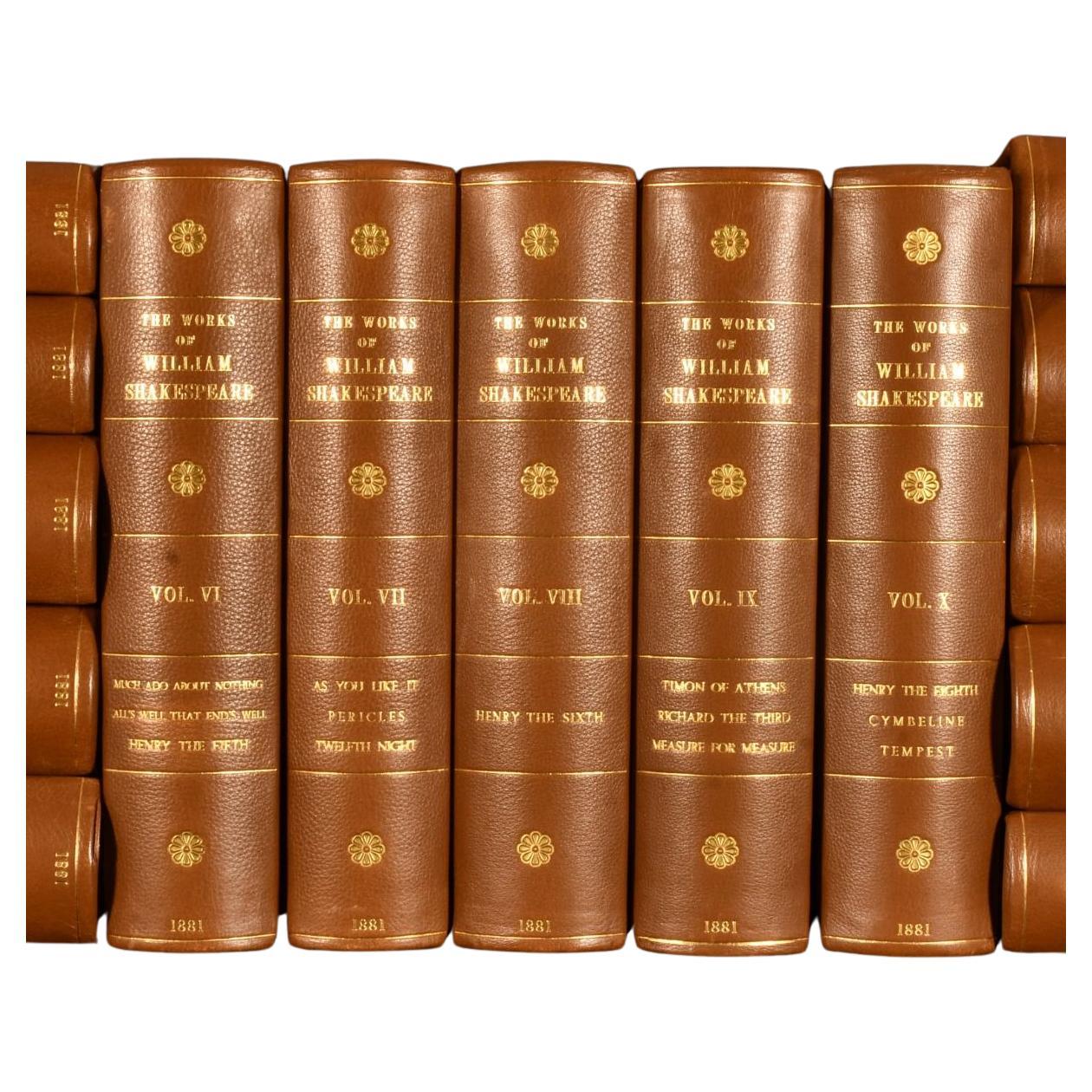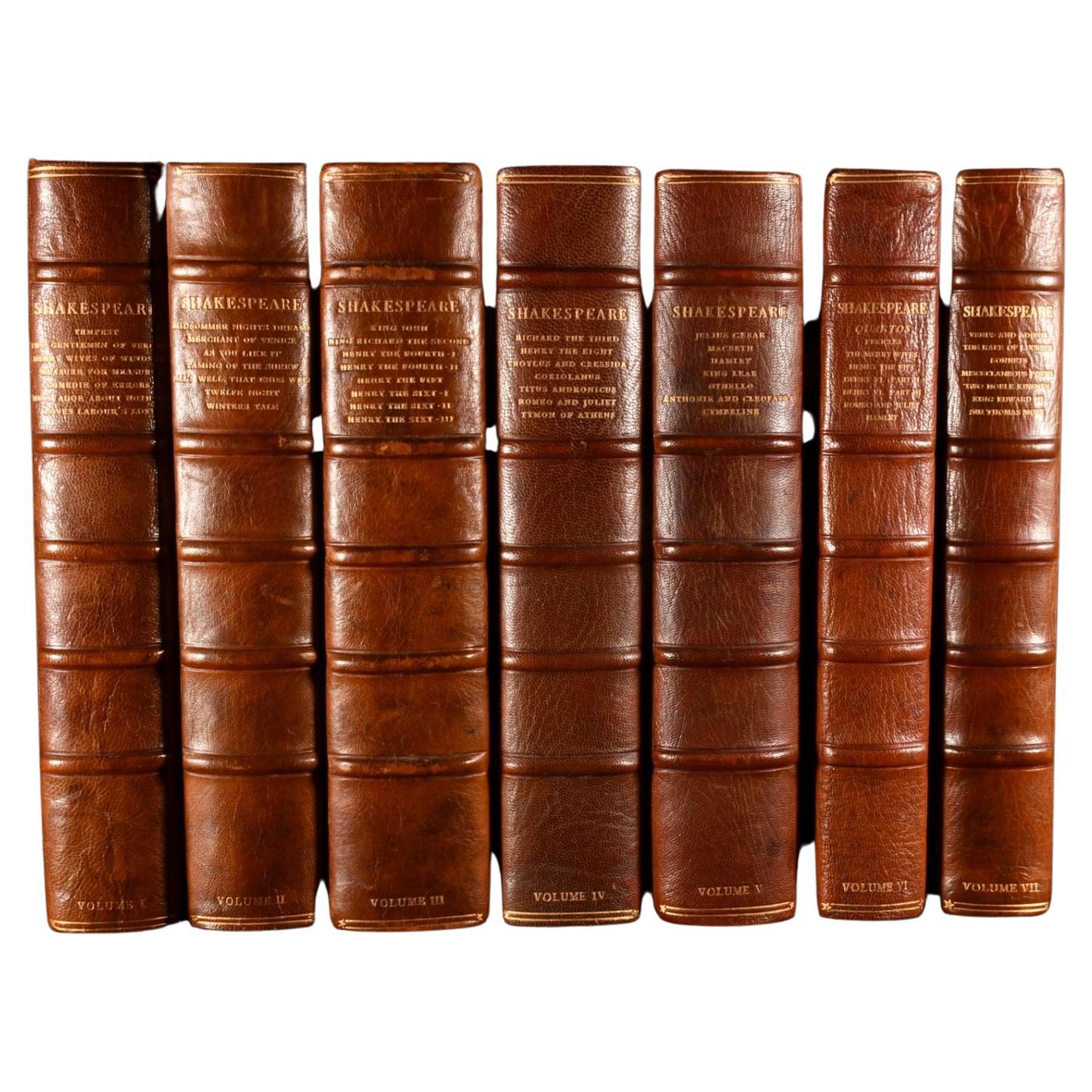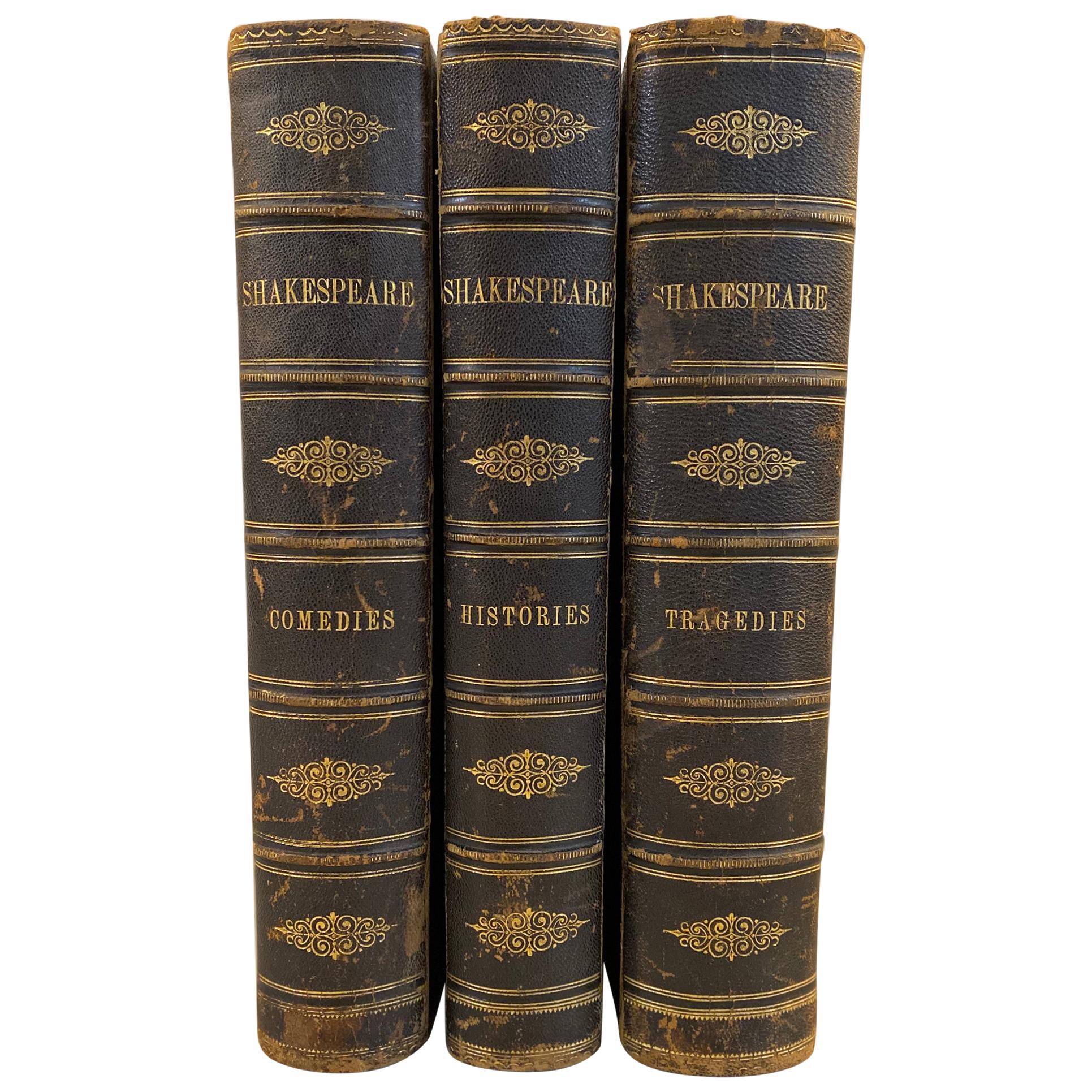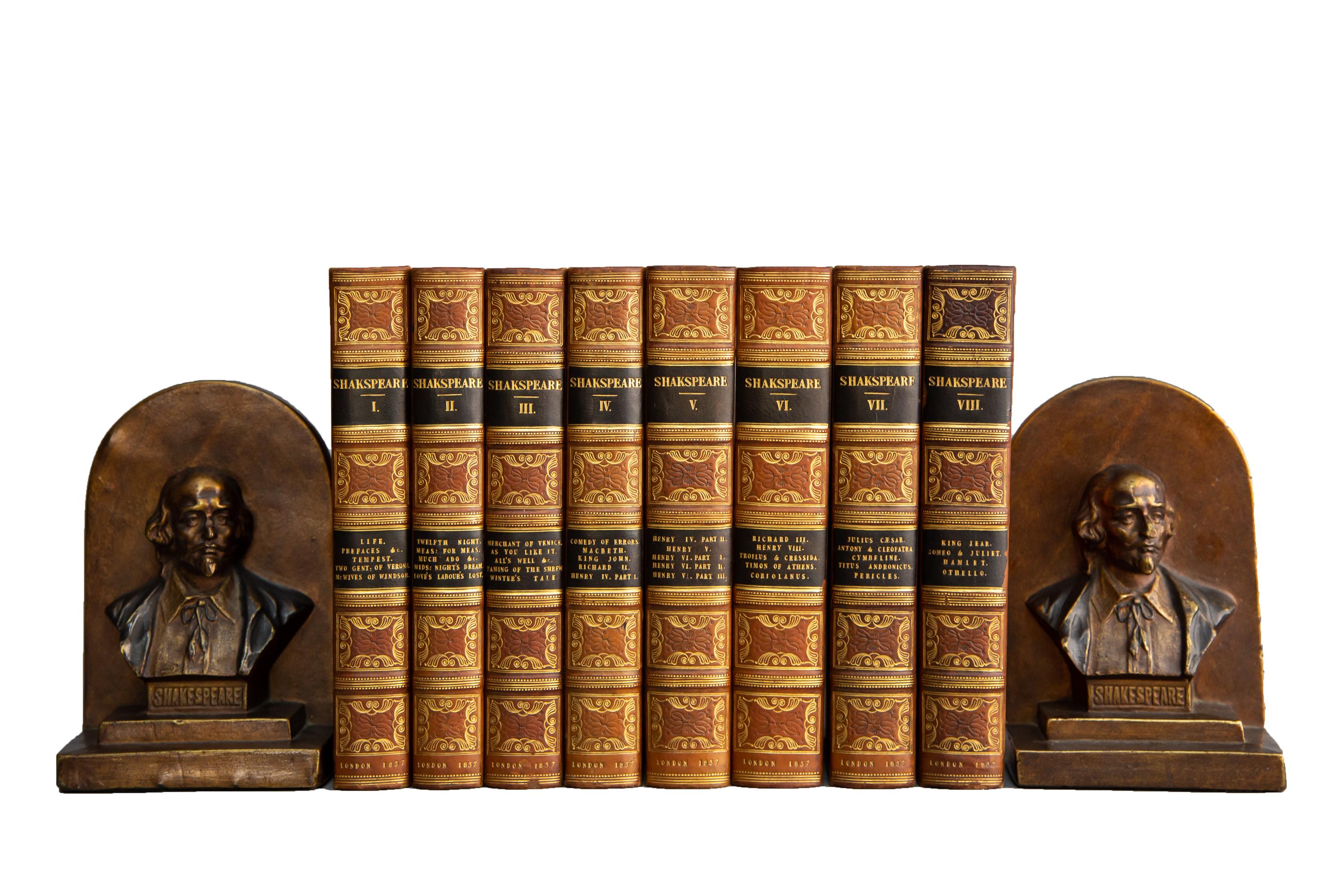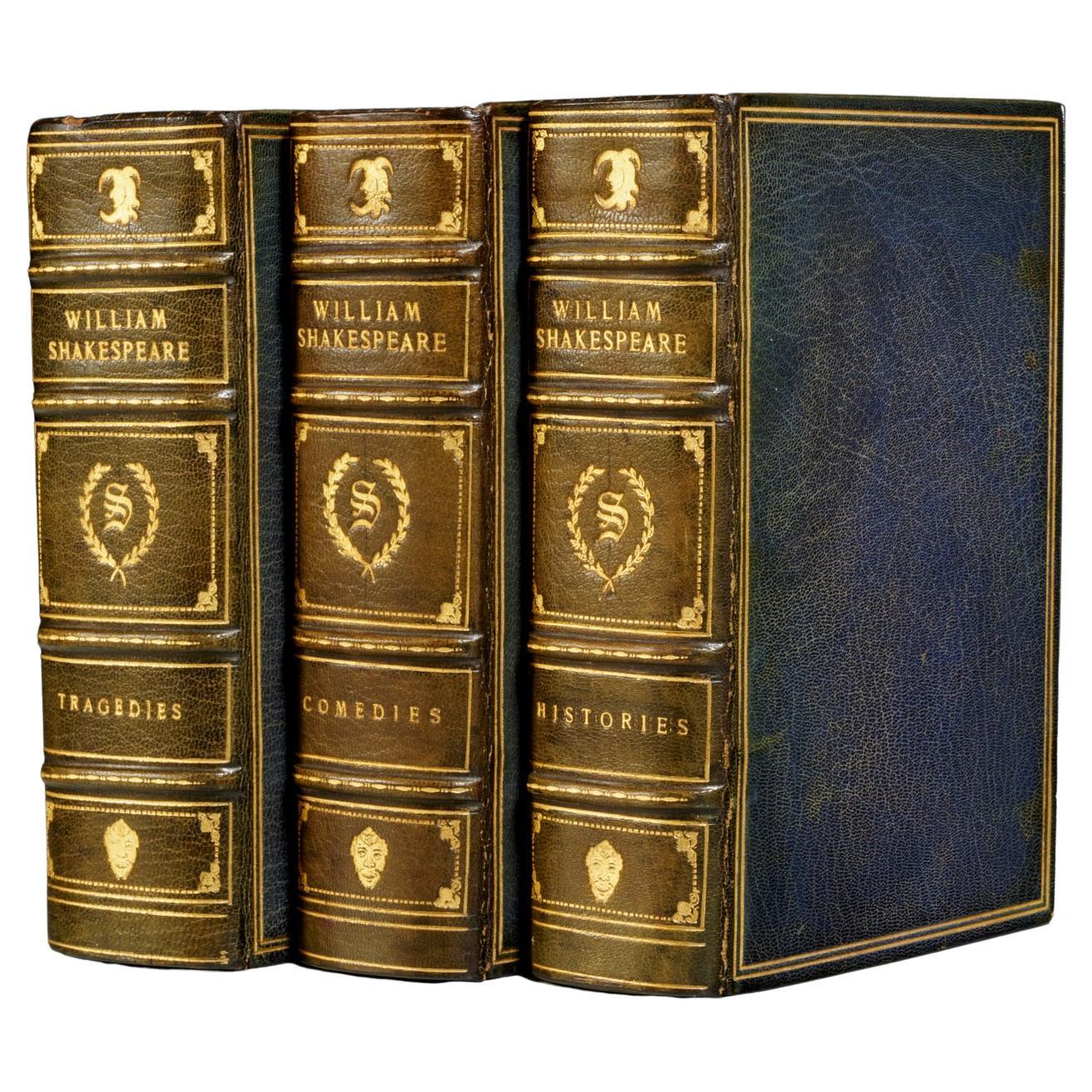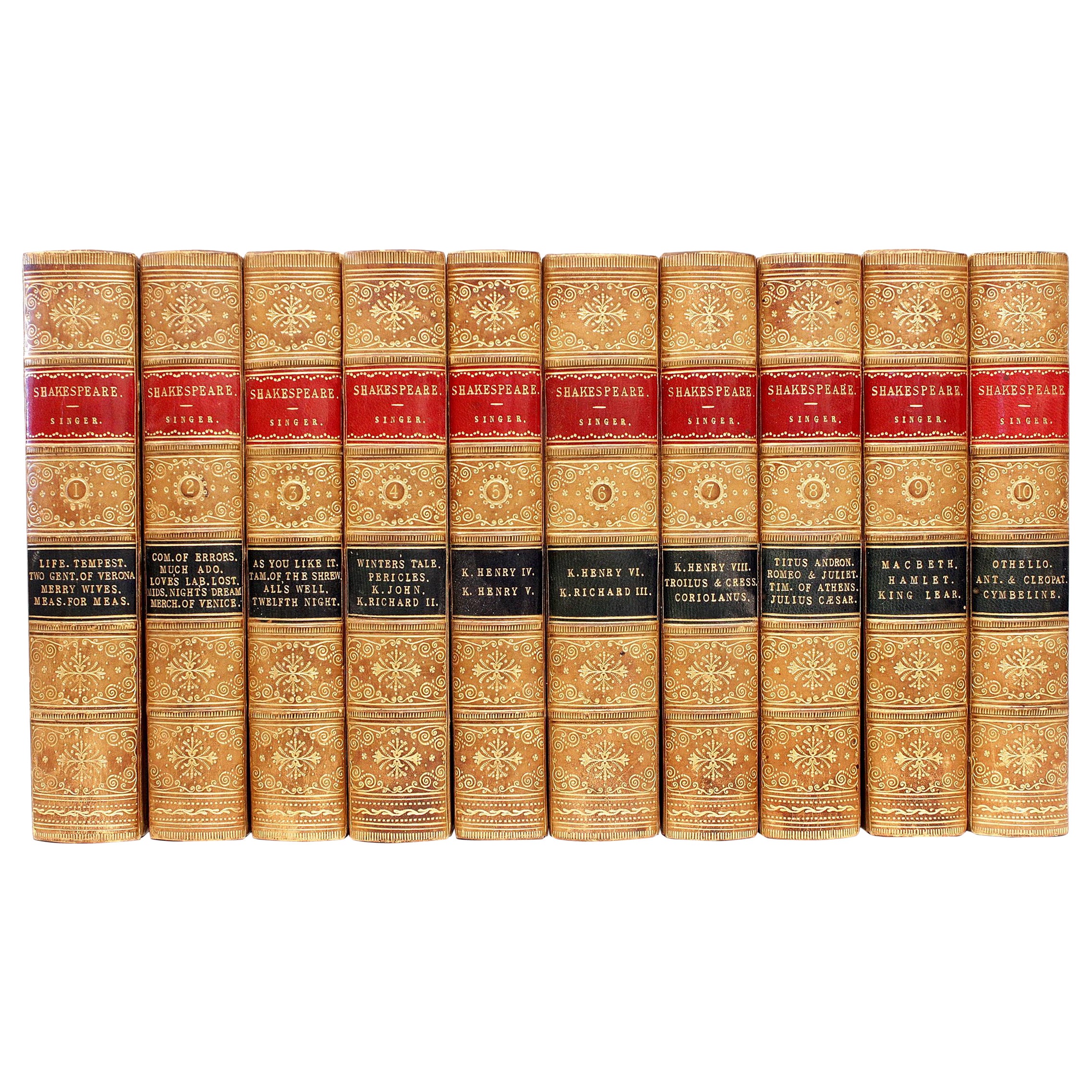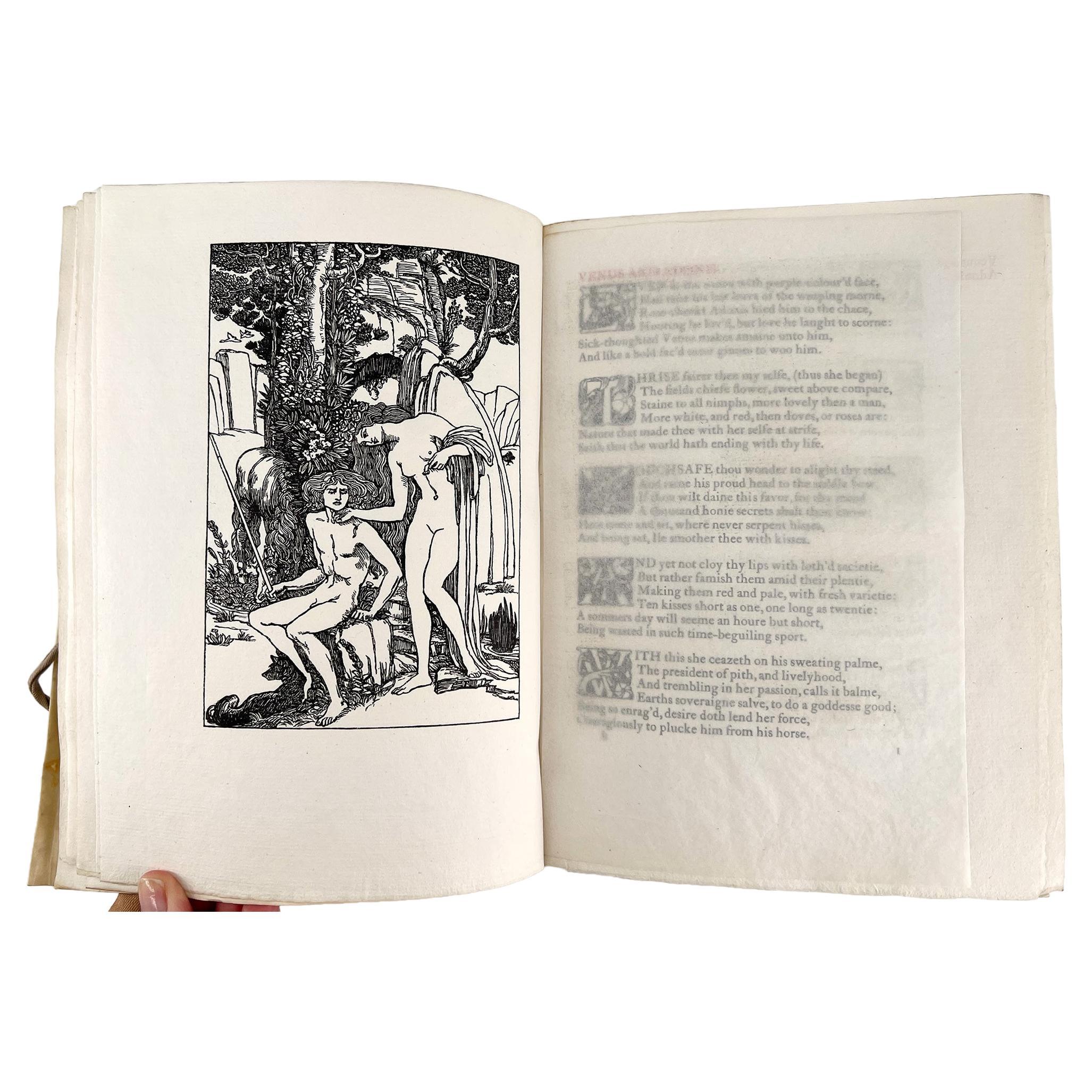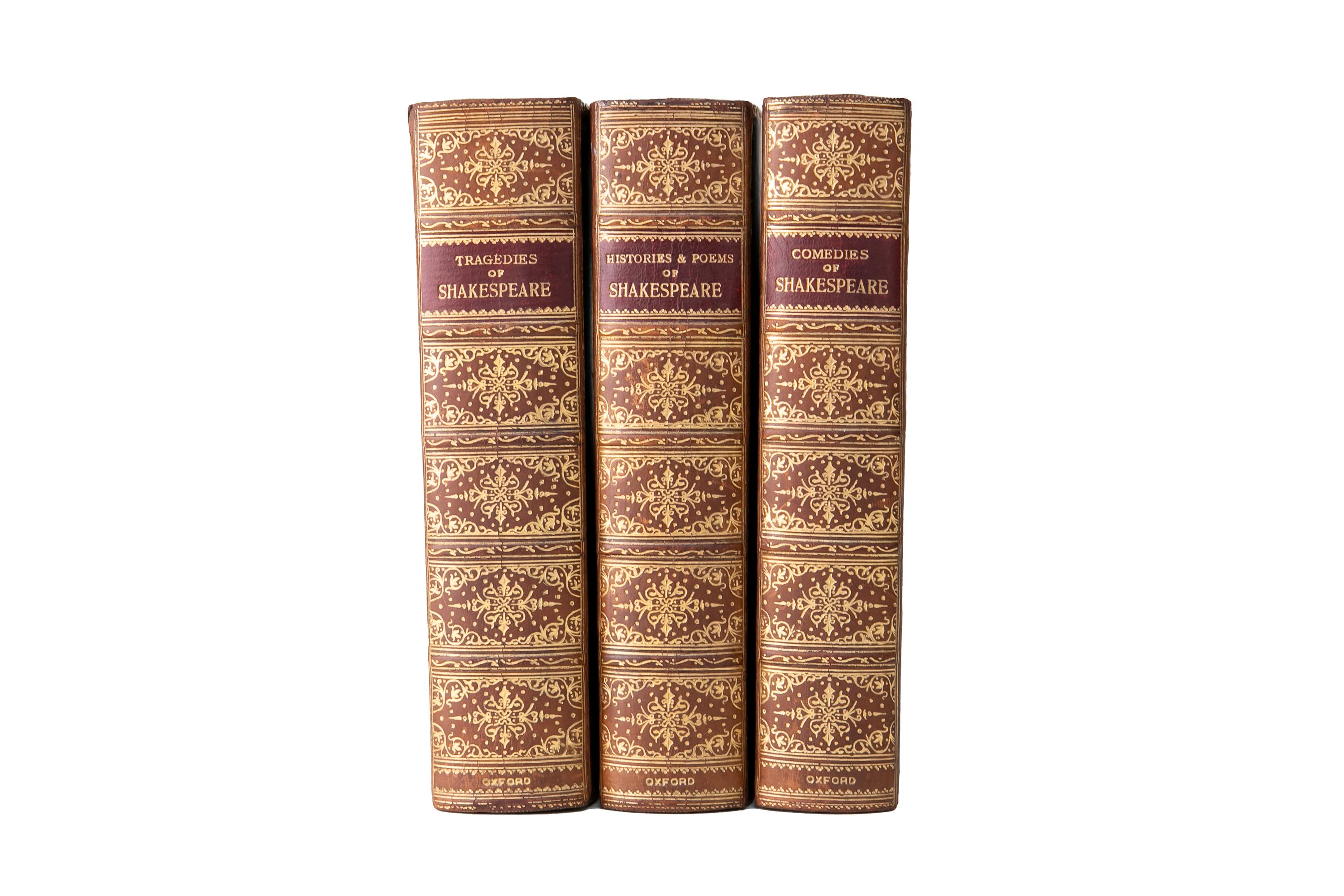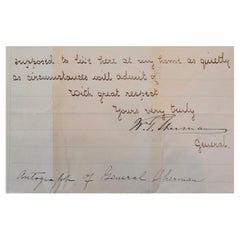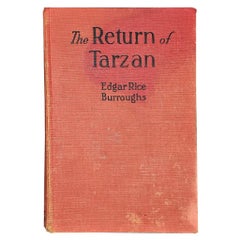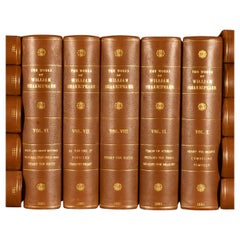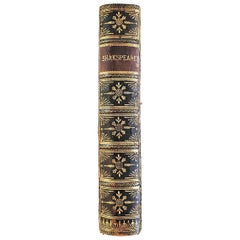
The Works of William Shakespeare 1868
View Similar Items
Want more images or videos?
Request additional images or videos from the seller
1 of 17
The Works of William Shakespeare 1868
About the Item
- Creator:William Shakespeare (Author)
- Dimensions:Height: 7 in (17.78 cm)Width: 5 in (12.7 cm)Depth: 1.3 in (3.31 cm)
- Style:High Victorian (Of the Period)
- Materials and Techniques:Paper,Engraved
- Place of Origin:
- Period:
- Date of Manufacture:1868
- Condition:Wear consistent with age and use. Minor structural damages. Fair to Good ORIGINAL CONDITION.
- Seller Location:Dallas, TX
- Reference Number:1stDibs: LU3978119509302
About the Seller
4.9
Platinum Seller
These expertly vetted sellers are 1stDibs' most experienced sellers and are rated highest by our customers.
Established in 2015
1stDibs seller since 2018
349 sales on 1stDibs
More From This SellerView All
- General William Tecumseh Sherman AutographLocated in Dallas, TXPRESENTING A RARE and FULLY AUTHENTIC General William Tecumseh Sherman Autograph. Last page of a hand written letter, circa 1885-1890. P...Category
Antique Late 19th Century American American Classical Historical Memorab...
MaterialsPaper
- The Return of Tarzan First EditionBy Edgar Rice BurroughsLocated in Dallas, TXPresenting a gloriously rare book …. The Return of Tarzan First Edition by Edgar Rice Burroughs Grosset & Dunlap 1st Edition. First edition. Il...Category
Early 20th Century American Romantic Books
MaterialsPaper
- The Son of Tarzan First EditionBy Edgar Rice BurroughsLocated in Dallas, TXPresenting a gloriously rare book …. The Return of Tarzan First Edition by Edgar Rice Burroughs Grosset & Dunlap 1st Edition. Very good +, squa...Category
Early 20th Century American Romantic Books
MaterialsPaper
- The Life of Francis Marion by Simms, 1855Located in Dallas, TXPresenting a very rare eleventh edition hardback illustrated copy of The Life of Francis Marion W. Gilmore Simms. J.C. Derby 119 Nassau Street, New York...Category
Antique Mid-19th Century American American Classical Books
MaterialsPaper
- Tarzan and the Jewels of Opar First EditionBy Edgar Rice BurroughsLocated in Dallas, TXPresenting a gloriously rare book …. Tarzan and the Jewels of Opar First Edition by Edgar Rice Burroughs Grosset & Dunlap 1st Edition. First Thus. Illustrated by J. Allen St. John...Category
Early 20th Century American Romantic Books
MaterialsPaper
- Rare 19th Century English Tunbridgeware Hair Pin or SlideLocated in Dallas, TXPresenting an absolutely gorgeous and extremely unique and rare 19th century British Tunbridgeware hair pin/bobbin or slide. This slide is unlike any of it’s kind we have seen before…. it is a very rare survivor ! From circa 1860–1880. Made of walnut with gorgeous marquetry inlay on the entirety of the front with classic Tunbridgeware micro-mosaic all over the front. The rear is walnut. The marquetry inlay appears to be various different woods, namely, maple, walnut and satinwood. Would have been worn in a Lady’s hair bun with the micro-mosaic facing forward. This would have belonged to a very elegant lady in the mid to late 19th century. Tunbridge ware is a form of decoratively inlaid woodwork, typically in the form of boxes, that is characteristic of Tonbridge and the spa town of Royal Tunbridge Wells in Kent in the 18th and 19th centuries. The decoration typically consists of a mosaic of many very small pieces of different coloured woods that form a pictorial vignette. Shaped rods and slivers of wood were first carefully glued together, then cut into many thin slices of identical pictorial veneer with a fine saw. Elaborately striped and feathered bandings for framing were pre-formed in a similar fashion. There is a collection of Tunbridge ware in the Tunbridge Wells Museum and Art Gallery in Tunbridge Wells. The famous makers of Tunbridge ware were in the Tunbridge Wells area of Kent; their most notable work was from circa 1830-1900. Early makers of Tunbridge ware, in Tunbridge Wells in the mid-18th century, were the Burrows family, and Fenner and Co. In the 19th century, around 1830, James Burrows invented a technique of creating mosaics from wooden tesserae. Henry Hollamby, apprenticed to the Burrows family, set up on his own in 1842 and became an important manufacturer of Tunbridge ware, employing about 40 people. Edmund Nye (1797–1863) and his father took over the Fenner company when William Fenner retired in 1840, after 30 years in partnership with him. Thomas Barton (1819–1903), previously apprenticed at the Wise factory, joined the Nyes in 1836, and worked as Nye’s designer; he took over the business in 1863 and continued there until his death. In Tonbridge (near to Tunbridge Wells), George Wise (1703–1779) is known to have had a business in 1746. It continued with his son Thomas, and Thomas’s nephew George (1779–1869), who took over in 1806. In its early years the company made articles such as workboxes and tea caddies with prints of popular views; later items had pictures created from mosaics. Their workshop in Tonbridge, Wise’s Tunbridge Ware Manufactory, was next to the Big Bridge over the Medway; the building was demolished in 1886 to widen the approach to the bridge. Tunbridge ware became popular with visitors to the spa town of Tunbridge Wells, who bought them as souvenirs and gifts. Articles included cribbage boards, paperweights, writing slopes, snuffboxes and glove boxes. At the Great Exhibition of 1851, Tunbridge ware by Edmund Nye, Robert Russell and Henry Hollamby was shown; Edmund Nye received a commendation from the judges for his work. He exhibited a table depicting a mosaic of a ship at sea; 110,800 tesserae were used in making the picture. The manufacturers of Tunbridge ware were cottage industries, and they were no more than nine in Tunbridge Wells and one in Tonbridge. The number declined in the 1880s; competent craftsmen were hard to find, and public tastes changed. After the death of Thomas Barton in 1903 the only surviving firm was Boyce, Brown and Kemp, which closed in 1927. Marquetry was an old technique which was continued by Nye and Barton to create images such as birds or butterflies. ‘Green Oak’ as caused by the fungus Chlorociboria aeruginascens. Stickware and half-square mosaic was invented by James Burrows in about 1830: a bunch of wooden sticks of different colours, each having triangular or diamond-shaped cross section, were tightly glued together; in the case of stickware, the resulting block was dried, then turned to form an article such as the base of a pincushion. For half-square mosaic, thin slices were taken from the composite block, and applied to a surface.[1][2][4] Tesselated mosaic, was a development by James Burrows of half-square mosaic; it was adopted by George Wise and Edmund Nye. Minute tesserae were used to form a wide variety of geometric and pictorial designs. Many sorts of wood were used for the various colours; about 40 were in regular use. Only natural colors were used; green was provided by “green oak”, produced by the action of fungus on fallen oak. Designs for articles were often taken from designs of Berlin wool work.Category
Antique Late 19th Century English High Victorian Collectible Jewelry
MaterialsSatinwood, Walnut
You May Also Like
- 1881 The Works of William ShakespeareBy William ShakespeareLocated in Bath, GBA superb limited edition set of the collected works of William Shakespeare, illustrated throughout by Sir John Gilbert. The collected works of William Shakespeare. A limited editio...Category
Antique 1880s British Books
MaterialsPaper
- 1929-1933 The Works of ShakespeareBy William ShakespeareLocated in Bath, GBA fantastic, bright set of this Nonesuch limited edition of William Shakespeare's works. The first edition of this Nonesuch set. A super set with much more even colour than usually seen. With the text based on the first folio, with quarto variants and a selection of modern readings. It follows the text of the First Folio faithfully, in its misprints and intermittent use of a comma for a full stop at the close of an uninterrupted speech. The editors note describes in detail the intention and treatment regarding substantive errors between the early editions. Numbered 60 of 1600 copies of this work, which have been designed by Francis Meynell and printed by Walter Lewis, printer to the University at the Cambridge University Press. The Nonesuch Press specialised in limited edition and private press. They were founded by Francis Meynell, his second wife Vera Mendel and their friend David Garnett. Their aspiration was for their publications to be aligned with the same aesthetic standards as the private press movement. They were unusual as they used a small Albion press...Category
Vintage 1930s British Books
MaterialsPaper
- 1813 The Plays of William ShakespeareBy William ShakespeareLocated in Bath, GBAn exceptionally bright example of the scarce 1813 twenty-one volume set of the plays of Shakespeare, supplemented with a wealth of comments and critical notices. The very scarce complete 1813 twenty-one volume edition of the plays of Shakespeare. Referred to as the Reed Edition of 1813, this is also known as Johnson-Steevens-Reed 6, the "sixth edition" by Johnson-Steevens, or the "second variorum edition". With notes by Samuel Johnson and George Steevens, this edition was revised and augmented by Isaac Reed. Consisting of: Volume I - Prefatory material and critical analysis by Reed, Richardson, and Malone. Illustrated with a portrait frontispiece, and four plates. Volume II - Essays by Farmer, Colman, lists of Editions, lists of Criticism, Commendatory verses, Malones "Attempt to Ascertain the Order of Shakespeare's Plays," Malone's essay on Ford's pamphlet, Steevens's remarks on the same. Volume III - Malone's Historical Account of the English Stage, and the Further Historical Account by Chalmers. With four folding plates. Volume IV - The Tempest; Two Gentlemen of Verona; Midsummer Night's Dream. Volume V - Merry Wives of Windsor; Twelfth Night. Volume VI - Much Ado About Nothing; Measure for Measure. Volume VII - Love's Labour's Lost; Merchant of Venice. Volume VIII - As You Like It; All's Well That Ends Well. Volume IX - Taming of the Shrew; Winter's Tale. Volume X - Macbeth; King John. Volume XI - King Richard II; King Henry IV, Part 1. With a folding plate. Volume XII - King Henry IV, Part 2; King Henry V. Volume XIII - King Henry VI, Part 1; King Henry IV, Part 2. Volume XIV - King Henry VI, Part 3; Dissertation, &c.; King Richard III. Volume XV - King Henry VIII; Troilus and Cressida. Volume XVI - Coriolanus; Julius Caesar. Volume XVII - Antony and Cleopatra; King Lear. Volume XVIII - Hamlet; Cymbeline. Volume XIX - Timon of Athens; Othello. Volume XX - Romeo and Juliet; Comedy of Errors. Volume XXI - Titus Andronicus...Category
Antique 1810s British Books
MaterialsPaper
- Works of William Shakespeare Comedies, Histories, Tragedies 3 VolumesLocated in San Francisco, CA19th century Works of William Shakespeare comedies, histories, tragedies 3 volumes Each volume is filled with a collection of outstanding highly detailed engravings Each volume...Category
Antique Late 19th Century English Books
MaterialsPaper
- 8 Volumes. William Shakespeare, The Plays of Shakespeare.Located in New York, NY8 Volumes. William Shakespeare, The Plays of Shakespeare. Bound in full tan calf with covers displaying gilt bordering. Raised band spine with panels displaying beautiful gilt detail...Category
Antique 1830s English Books
MaterialsLeather
- The Works of William Shakespeare, Mayfair Edition Bound in English Niger LeatherBy Albert MaurinLocated in Morristown, NJThe Works of William Shakespeare - The Definitive Text, With Notes and Glossary, The Mayfair Edition, New York Three small octavo volu...Category
Vintage 1920s American Art Nouveau Books
MaterialsGold
Recently Viewed
View AllMore Ways To Browse
Shakespeare Book
Antique Bowling
Civil War Antique Books
Antique Western Leather
New Bedford Antique
Victorian Jacket 19th Century
Antique Shakespeare Books
Antique Leather Jacket
Antique Leather Jackets
Texas Victorian
Robert Ogden
The Works Of Shakespeare
General Lee
General Robert E Lee
Bowling Sign
The Works Of William Shakespeare
William Godwin Books
Books And Letters
